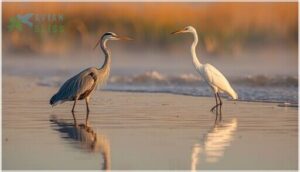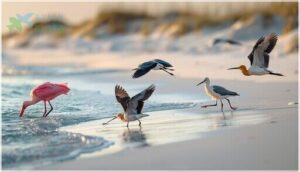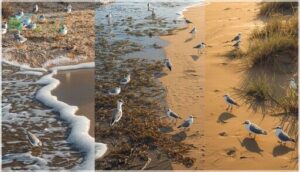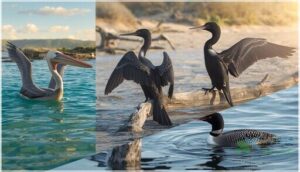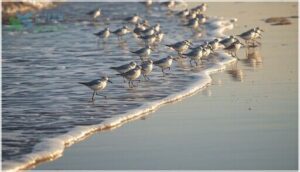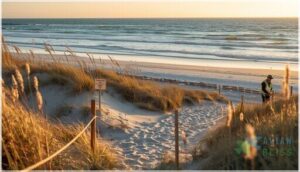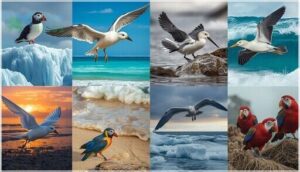This site is supported by our readers. We may earn a commission, at no cost to you, if you purchase through links.
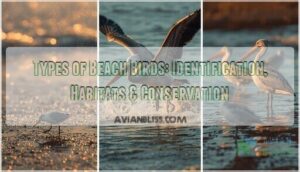 A single Snowy Plover weighs less than a AA battery, yet it migrates thousands of miles along coastlines most of us will never see. Meanwhile, a Brown Pelican—tipping the scales at nearly two pounds—plunges from 60 feet above the surf to snag fish with surgical precision.
A single Snowy Plover weighs less than a AA battery, yet it migrates thousands of miles along coastlines most of us will never see. Meanwhile, a Brown Pelican—tipping the scales at nearly two pounds—plunges from 60 feet above the surf to snag fish with surgical precision.
The types of beach birds you’ll encounter aren’t just different species sharing the same zip code; they’re evolutionary specialists carved by distinct survival strategies. Some probe mudflats on stilts, others skim the surface with bills that slice through water like scissors, and a few wade belly-deep where shorter legs wouldn’t stand a chance.
Understanding what separates a tern from a gull, or why one shorebird’s bill curves down while another’s points straight, reveals how these birds claim their niches in one of Earth’s most competitive ecosystems.
Table Of Contents
- Key Takeaways
- Beach Bird Identification
- Gulls and Terns
- Herons and Egrets
- Other Florida Beach Birds
- Beach Bird Habitats
- Beach Sharing Etiquette
- Common Beach Birds
- Threatened and Endangered Species
- Beach Bird Conservation
- Global Beach Bird Diversity
- Frequently Asked Questions (FAQs)
- What kind of birds run on the beach?
- What are the birds you see at the beach?
- What is the most common shore bird?
- What do you call the birds on the beach?
- What is the best time of day to spot beach birds?
- How can I recognize different species of beach birds in flight?
- What is the typical lifespan of a beach bird in the wild?
- Can I attract beach birds to my backyard with food and water?
- What do beach birds eat in winter?
- How do beach birds navigate during migration?
- Conclusion
Key Takeaways
- Beach birds are evolutionary specialists with distinct body types—long-legged waders like avocets probe deep waters up to 10 cm, while short-legged plovers dominate shallow zones with compact builds designed for speed and maneuverability along the surf.
- Identification hinges on observable adaptations: bill curvature reveals feeding strategy (downcurved for deep probing, straight for surface prey), leg proportions dictate accessible water depth (ranging 2-15 cm across species), and wing shape indicates flight behavior (narrow for diving terns, broad for soaring pelicans).
- Sandy beaches aren’t just habitat—they’re survival infrastructure where kelp wrack deposits create invertebrate hotspots that fuel entire coastal food webs, yet mechanical grooming destroys these resources by raking away the top 10-15 cm of sand where prey species burrow.
- Conservation status varies dramatically by species, with some populations like interior Least Terns rebounding from under 2,000 to over 18,000 through targeted habitat protection, while Western Snowy Plovers remain threatened at roughly 2,000 individuals due to recreational disturbance and predation claiming 48% of nests.
Beach Bird Identification
When you’re scanning the shoreline, you’ll notice that beach birds come in all sorts of shapes and sizes, each adapted to their own way of making a living. Some stand tall on stilts for legs, while others stay close to the sand on stubby limbs.
Let’s break down the key body types you’ll encounter so you can start identifying these coastal birds with confidence.
Shorebird Shapes and Sizes
When you’re eyeing shorebirds, body size trends reveal a lot—species range from under 20 grams to over 700 grams. Check bill length and wing shape; some wingspans stretch 80 cm. Leg proportions matter too, varying from 2 cm to 15 cm across shorebird species.
Notice feather patterns and how physical characteristics shift with climate—smaller bodies, longer bills. These clues turn your beach walk into a genuine identification adventure.
Long-legged and Slim Birds
Long-legged waders like the American Avocet, Long-billed Curlew, and Black-necked Stilt dominate shallow marshes and mudflats. These shorebird species showcase dramatic leg length variations—some wade safely in water up to 10 cm deep. Their slim body plans and specialized bird leg anatomy enable unique wading techniques:
- Bills sweep side-to-side underwater targeting crustaceans
- Legs span 2–15 cm, dictating feeding depth
- Tarsus proportions access resources shorter-legged birds can’t reach
Short-legged and Stout Birds
Unlike their long-legged cousins, short-legged and stout birds hustle at the water’s edge using compact builds and powerful bills. You’ll spot plovers—averaging 7–8 inches—scurrying across sandy shores with rounded wings and cryptic plumage that blends into coastal habitats. The Wilson’s Plover wields a thick black bill perfect for beach foraging, cracking fiddler crabs that comprise over 90% of its diet. Ruddy Turnstones, with orange legs and distinctive black-and-white heads, flip debris along rocky shorelines. These stout bird species avoid competition through specialized feeding—shorter bills target shallow waters where other shorebird species can’t reach.
- Plovers: Over 60 species worldwide, with some completing impressive plover migration routes across entire continents
- Turnstones: Global population between 750,000–1,750,000, though eastern populations declined 80% since 1980
- Sanderlings: Black-legged speedsters chasing surf zones, their short bills perfectly adapted for catching prey in breaking waves
Sandpipers and Their Variations
Sandpipers represent nearly 100 distinct species within the family Scolopacidae, each adapted to specific coastal bird habitats and feeding habits. You’ll find these shorebird species probing mudflats with specialized bills, their breeding patterns ranging from monogamous Semipalmated Sandpipers nesting near tundra ponds to polyandrous Spotted Sandpipers—North America’s most widespread breeding sandpiper.
Sandpiper migration routes span continents, with some covering 1,800–2,500 miles nonstop. Their habitat preferences and conservation status vary widely across populations.
Sandpipers often engage in social mating behaviors, which play a vital role in their reproductive success.
Curlews and Their Relatives
Curlews command attention with their elegantly downcurved bills—sometimes reaching eight inches in the Long-billed Curlew—and haunting calls echoing across coastal bird habitats. Nine true curlew species exist worldwide, though habitat loss has driven some toward extinction.
You’ll observe their feeding habits as they probe mudflats for invertebrates, their bills perfectly adapted for deep foraging. Curlew migration spans continents, making bird identification vital for shorebird species conservation and protecting diverse wading bird populations.
Conservation efforts focus on addressing curlew population decline to safeguard these species.
Gulls and Terns
Gulls and terns are two of the most recognizable groups of beach birds you’ll encounter along the coast, each with their own distinctive features and behaviors. While gulls are the larger, more sturdy scavengers you often see patrolling beaches, terns are slimmer, more graceful fliers that specialize in plunge-diving for fish.
Understanding the key differences between these groups will help you identify the specific species you come across during your coastal adventures.
Characteristics of Gulls
You’ll recognize gulls by their sturdy bodies, stout hooked beaks, and fully webbed feet built for swimming. Most gull species display white or gray plumage with darker wing mantles and distinctive black wingtips, though plumage variations help distinguish one species from another.
These highly social seabirds nest in dense colonies, communicating through complex calls—Laughing Gulls earn their name from their distinctive vocalizations.
Their feeding habits are opportunistic, shifting between fish, marine invertebrates, and even human refuse depending on what’s available.
Types of Gulls
You’ll encounter over 50 gull species worldwide, each adapted to different coastal habitats. Laughing Gulls sport black heads and red bills, their namesake calls echoing across beaches. Ring-billed Gulls display distinctive yellow bills with black bands, while Herring Gulls—among the largest—feature pink legs and hefty builds. Great Black-backed Gulls dominate northern coasts with impressive 1.7-meter wingspans.
Gull migration patterns vary: some northern species travel south seasonally, while southern populations stay put year-round.
Characteristics of Terns
When you catch sight of a tern, you’ll notice its slender body, forked tail, and aerodynamic design—built for diving headfirst after fish. Tern species measure 20–55 cm, with wingspans up to 140 cm.
Their pale gray and white plumage lacks waterproofing, so you won’t see them resting on water. Feather adaptation and beak structure vary: some bills are black-tipped, others entirely black or yellow, enabling precise fish capture.
Types of Terns
Over 40 tern species inhabit coastlines worldwide, each adapted to unique niches. You’ll recognize these seabirds by their distinct feather characteristics and nesting habits:
- Royal Tern – Orange bill, deep forked tail, plunge-diving specialist
- Least Tern – Smallest North American species at 23 cm, federally threatened
- Common Tern – Most widespread, migrates to Argentina
- Arctic Tern – Record-holder for tern migration, traveling 96,000 km annually
Seabird conservation efforts focus on protecting their vulnerable breeding colonies.
Herons and Egrets
Herons and egrets are among the most striking wading birds you’ll spot along the shoreline, with their long legs, sharp beaks, and patient hunting styles.
These elegant birds come in various colors and sizes, from pure white egrets to steel-blue herons. You can identify them by their plumage color and whether they prefer hunting solo or gathering in groups.
White Herons and Egrets
You’ll find two stunning white coastal bird species along Florida’s shorelines: the delicate Snowy Egret, showing off bright yellow feet and a global population around 3 million, and the larger Great Egret, with wingspans reaching five feet.
Watch how egret feeding habits shift with water levels—these herons target fish primarily, though Great Egrets diversify their diet more.
Both species nest socially in wetland colonies, and while Great Egrets face habitat decline in some regions, supporting heron conservation through responsible bird identification and shorebird species protection remains vital for maintaining their white plumage gracing our beaches.
Grey or Blue Herons
You’ll recognize Grey Herons and Great Blue Herons by their towering stance and blue-gray plumage—these coastal bird species are top predators found across wetlands, marshes, and beaches worldwide. Bird species on beaches include these exceptional hunters, with Grey Heron habitat spanning Eurasia while Great Blue Herons dominate North America. Consider heron behavior patterns when observing:
- Fish dominate blue heron diet, with prey up to 25 cm long
- Heron migration distances reach 6,000 km seasonally
- Grey Heron habitat includes lakes, rivers, and sea coasts
- Europe hosts 223,000 to 391,000 breeding pairs annually
- Heron species identification relies on bill color and plumage
Despite stable populations, heron conservation efforts address habitat loss threatening these solitary or colonial nesters.
Solitary and Social Behavior
Beyond their striking blue-gray plumage, these coastal bird species exhibit fascinating behavioral contrasts. You’ll spot herons foraging alone—solitary behavior driven by specialized hunting tactics and reduced competition—while egrets demonstrate complex colony dynamics during breeding.
Nesting patterns shift dramatically: monogamous pairs defend territories yet tolerate proximity in rookeries exceeding 500 individuals. Social learning occurs in colonial settings, where juveniles observe foraging strategies. This duality reflects adaptive responses to resource distribution and predation pressure across beach habitats.
Other Florida Beach Birds
Beyond the herons and egrets, Florida’s coastline hosts several distinctive species that you won’t want to miss on your beach walks.
These birds stand out with unique feeding strategies and striking appearances that make them easy to spot once you know what to look for.
Let’s explore four exceptional species that call Florida’s beaches home.
Roseate Spoonbill
You won’t mistake the Roseate Spoonbill once you spot its candy-pink plumage wading through Florida’s shallow marshes. This coastal bird species stands out with its bizarre spatula-shaped bill, sweeping side-to-side underwater to detect fish, crustaceans, and aquatic insects. Spoonbill identification gets easier when you notice their greenish heads and deep red wings during breeding season. Their behavior reflects social tendencies, gathering in mixed flocks with herons and egrets. Thanks to habitat restoration and bird conservation efforts, spoonbill migration routes now extend from Cuba to coastal Texas, with over 30,000 individuals thriving across North America.
- Bright pink feathers intensify from carotenoid-rich prey
- Roseate feeding occurs in waters less than five inches deep
- Adults measure 28-34 inches with impressive 47-52 inch wingspans
- Nesting colonies form on mangroves up to sixteen feet high
- Watch for them sweeping mudflats at dawn and dusk
White Ibis
Watch for White Ibis patrolling Florida’s wetland habitat with distinctive curved red bills sweeping through mud. These coastal bird species, sporting snowy white feathers and scarlet facial skin, feast on crayfish, crabs, and insects you’ll find in shallow marshes.
Their ibis diet shifts with seasonal rainfall, influencing ibis migration patterns between coastal colonies and inland feeding grounds. Bird conservation efforts focus on protecting their shrinking freshwater foraging areas across threatened shorebird species ranges.
Black Skimmer
You’ll spot the Black Skimmer slicing through coastal waters with its jaw-dropping lower mandible, dragging beneath the surface to snag fish in shallow estuaries and tidal creeks. This seabird’s skimming techniques and distinctive plumage make bird identification easy during evening foraging sessions.
Beach birds like these face serious challenges:
- Habitat loss threatens nesting sites on sandy beaches
- Coastal development disrupts their feeding habits
- Conservation status declines continue across Gulf populations
- Human disturbance impacts colony survival rates
Oystercatcher
You’ll recognize the American Oystercatcher by its striking orange-red bill and bold black-and-white feather characteristics that make bird identification a breeze along coastal zones. This shorebird species measures roughly 40-45 cm long, specializing in a shellfish diet of clams, oysters, and mussels during low tide foraging sessions.
Beach nesting occurs on sandy shores and marsh islands, where pairs raise their young. Despite a conservation status upgrade from 10,000 to over 14,000 individuals since 2009, oystercatcher migration patterns reveal ongoing vulnerability:
- Habitat loss from coastal development threatens breeding sites
- Sea level rise compounds nesting challenges
- Human disturbance disrupts reproductive success
- Climate change impacts oystercatcher characteristics and survival rates
Beach Bird Habitats
Beach birds don’t just show up anywhere—they need specific conditions to survive and thrive. Sandy beaches provide essential nesting grounds and feeding zones, while natural features like kelp wrack support entire food webs that keep these birds coming back.
Understanding what makes a beach suitable for birds helps explain why some shorelines buzz with activity while others remain relatively quiet.
Importance of Sandy Beaches
Sandy beaches aren’t just pretty backdrops—they’re lifelines for coastal bird species. These active coastal ecosystems provide critical beach bird habitats where shorebird species nest, forage, and rest during migration. Sandy dunes offer shelter from predators and harsh weather, while delivering essential ecosystem services like coastal protection and shoreline stability. Without healthy beaches, you’d witness dramatic declines in populations already threatened by beach erosion and habitat loss.
| Habitat Feature | Bird Function | Conservation Value |
|---|---|---|
| Open Sandy Beaches | Foraging grounds for invertebrates | Buffers storm damage, prevents billions in coastal losses |
| Vegetated Dunes | Nesting sites, predator protection | Carbon storage, erosion control |
| Wrack Lines | Concentrated food sources | Nutrient cycling, water filtration |
Kelp Wrack and Sand-dwelling Invertebrates
You’ve probably walked past kelp wrack without realizing it’s a biodiversity goldmine. These tangled seaweed deposits host thriving invertebrate communities—amphipods, polychaetes, tiny clams, and isopods—that fuel beach food webs and keep shorebirds fed. Sandy shore dynamics and coastal ecosystems depend on this wrack, creating hotspots where marine invertebrates flourish in coastal habitats:
- Amphipods thrive in decomposing kelp
- Storm waves deliver fresh wrack deposits
- Invertebrate diversity peaks on natural beaches
- Wider beaches retain more nutrient-rich material
- Sanderlings hunt these invertebrates relentlessly
Beach Grooming Practices
Mechanical grooming might create those picture-perfect sandy beaches you love, but it’s wreaking havoc on coastal habitats. When heavy machinery rakes the top 10–15 centimeters of sand, it destroys invertebrate burrows and disrupts the coastal ecosystems beach birds rely on for food.
Coastal management priorities often clash with ecological restoration needs, leaving shoreline habitats stripped bare and bird populations struggling to survive.
Beach Sharing Etiquette
When you share the beach with nesting and foraging birds, a few simple practices can make all the difference in protecting their habitat. Small adjustments to how you move through these coastal spaces help minimize stress on vulnerable species during critical feeding and breeding periods.
Here’s what you can do to be a respectful beach visitor while still enjoying your time by the water.
Respecting Bird Habitat
You can’t enjoy the beach without recognizing it’s home turf for birds that depend on these coastal habitats year-round. Respecting bird habitats and bird-friendly zones means protecting nesting colonies and wildlife refuges that keep coastal ecosystems thriving.
- Keep your distance from marked bird nesting colonies and coastal conservation areas
- Skip feeding wild birds—it disrupts natural foraging and harms eco-tourism practices
- Leash your pets near designated bird habitats and ranges
- Watch noise levels to support habitat preservation efforts for vulnerable species
Minimizing Disturbance
Your actions on the beach directly affect bird conservation status and breeding success. Disturbance reduction doesn’t require sacrifice—just awareness. In managed areas where beach-friendly zones limit human impact mitigation, shorebird productivity climbed markedly. You can support these conservation strategies by:
- Keeping dogs leashed near coastal habitats where birdwatching thrives
- Silencing music that disrupts nesting colonies
- Avoiding drones over bird friendly zones
- Never feeding birds in habitat protection areas
Cleaning Up After Yourself
Beyond keeping quiet and staying back, your trash choices shape wildlife conservation outcomes. Beach litter—especially plastic pollution—kills shorebirds through ingestion and entanglement.
Remove everything you bring: wrappers, bottles, fishing line fragments. These sustainable practices protect coastal ecosystems where beach birds nest and feed.
Eco-friendly habits strengthen conservation efforts, improving bird conservation status across shoreline habitats. Your cleanup commitment matters more than you’d think.
Common Beach Birds
You’ll encounter a wide variety of birds during your beach visits, and learning to recognize the most common species can deepen your appreciation for coastal ecosystems.
From the nimble plovers darting along the waterline to the majestic pelicans soaring overhead, each species has adapted unique behaviors for life at the shore.
Let’s look at some of the beach birds you’re most likely to spot on your next coastal adventure.
Plover Species
You’ll recognize plovers by their compact build, short bills, and striking black breast bands. Wilson’s Plover, Piping Plover, and Western Snowy Plovers thrive on sandy beaches, but habitat loss threatens their nesting habits.
Black-bellied Plovers, sporting seasonal plumage changes, demonstrate impressive plover migration patterns across continents.
Species diversity among these shorebirds reflects nature’s adaptability, yet bird conservation efforts remain critical as human activity disrupts their fragile coastal breeding grounds.
Pelicans, Cormorants, and Loons
You’ll find pelicans, cormorants, and loons among the most engaging coastal bird species on beaches. Here’s what makes these seabirds noteworthy:
- Pelican migration: Brown and American White Pelicans move between breeding and wintering grounds, with populations exceeding 650,000 individuals globally in wetland habitats.
- Cormorant breeding: Double-crested Cormorants construct stick nests on islands, with 40 species distributed worldwide across diverse environments.
- Loon ecology: Five loon species exist, with Common Loons producing haunting calls during territorial disputes that sometimes prove fatal for displaced males.
Bird conservation efforts protect these extraordinary species.
Grebes and Gulls
During beach visits, you’ll spot grebes and gulls displaying striking behaviors. Grebes exhibit unique feather ingestion to aid digestion, with Eared Grebe populations reaching 3.7 million across North America. These divers shift from insects to fish seasonally, following distinctive migration patterns to saline lakes.
Meanwhile, gull species like the Laughing Gull thrive in vibrant colony settings, their feeding ecology adapting opportunistically between marine and urban food sources. Gull colony dynamics vary dramatically—Kelp Gull sites range from mere pairs to over 3,000 individuals, reflecting population trend variations across diverse coastal habitats.
Sanderlings and Their Behavior
You’ll often watch Sanderlings scurrying along the shoreline in mesmerizing waves, their rapid foraging behavior perfectly synchronized with retreating surf. These notable sandpipers demonstrate complex social dynamics and impressive shorebird adaptations across diverse mudflats and coastal habitats.
- Migration patterns span up to 10,000 km between Arctic breeding grounds and tropical wintering sites
- Foraging strategies shift dramatically—spending 79% of daylight hours feeding in temperate zones versus just 38% in tropical areas
- Breeding habits include flexible incubation roles, with either parent capable of raising chicks independently
- Conservation threats include habitat loss from beach development and declining prey availability due to climate change
Threatened and Endangered Species
Not all beach birds you’ll encounter are thriving in the wild. Some species face serious threats from habitat loss, human disturbance, and environmental changes that have pushed them onto endangered species lists.
Let’s look at a few of these vulnerable beach birds and what’s being done to help them survive.
Western Snowy Plovers
The Western Snowy Plover embodies the fragility of coastal habitats. Listed as threatened since 1993, this diminutive shorebird now numbers only about 2,000 along California’s sandy beaches. Population decline stems from four critical factors:
- Nesting threats: Beach recreation during March through September disrupts breeding.
- Habitat loss: Coastal development and invasive plants reduce suitable areas.
- Predation pressure: Mammals account for 48% of nest failures.
- Human disturbance: Foot traffic imperils eggs and chicks.
Recovery efforts through symbolic fencing and public education have shown promising results, with some sites now exceeding productivity targets.
Least Terns
Standing just nine inches tall, Least Terns represent one of North America’s most vulnerable seabirds, having lost 79% of their population between 1966 and 2023. You’ll find these agile tern species along sandy beaches and gravel rooftops from April to August, where their distinctive black-capped heads and sharp diving skills make tern species identification straightforward.
Least Terns, nine-inch seabirds with black caps and sharp diving skills, have lost 79% of their population since 1966
However, their population trends tell a sobering story: predation claims 47% of nests, while habitat loss and human disturbance threaten breeding colonies.
Despite conservation challenges, the interior subspecies rebounded from under 2,000 to over 18,000 birds through targeted habitat preservation and predator management, proving recovery is possible.
Conservation Efforts
Conservation efforts for imperiled beach birds depend on both wildlife funding and your participation. Habitat restoration projects secured $102.9 million in 2025 to protect critical nesting areas, while beach cleanups combat plastic pollution threatening coastal ecosystem preservation.
You’ll strengthen species protection through volunteer monitoring, supporting conservation strategies that limit human disturbance during breeding seasons, and advocating for responsible beach management.
Bird conservation efforts work—targeted interventions have increased some populations over 50%.
Beach Bird Conservation
Beach birds face mounting pressures from habitat loss, human disturbance, and climate change, but you can make a real difference in their survival. Whether you’re a casual beachgoer or a dedicated birder, there are concrete actions you can take to protect these coastal species.
Here are four practical ways to support beach bird conservation and help guarantee these extraordinary birds continue to flourish along our shorelines.
Supporting Conservation Organizations
Your support can fuel real change for coastal birds—and you don’t need to be an expert to start. Conservation funding drives habitat restoration projects, while volunteer recruitment brings passionate people like you to protect nesting sites.
Whether you donate, join community engagement programs, or participate in bird conservation efforts, your involvement strengthens coastal ecosystem preservation.
These conservation efforts rely on people who care enough to act, turning concern into tangible protection for threatened beach bird species and their habitats.
Educating Yourself and Others
You can boost conservation efforts by sharpening your bird identification skills through bird watching and environmental awareness programs. Over 4,000 students join field-based coastal bird species training annually, learning identification techniques that stick—82% retain knowledge a year later.
Share bird watching tips with your circle, participate in community engagement projects, and use educational resources to turn casual beachgoers into informed stewards of bird habitats.
Advocating for Responsible Beach Management
You’ve built your knowledge—now let your voice carry it forward. Push for coastal policy changes that prioritize beach restoration and dune preservation over development.
Back eco-tourism initiatives that fund conservation efforts while creating jobs.
Join community engagement projects that challenge harmful beach grooming practices. Your advocacy shapes how coastal habitats and environments survive, protecting coastal bird behavior and the beach birds that depend on responsible stewardship.
Minimizing Your Impact
Every time you visit coastal habitats and environments, your choices directly affect conservation of bird species. Responsible visitation means practicing sustainable tourism that protects beach birds and their fragile ecosystems. Simple eco-friendly actions make real differences:
- Keep dogs leashed—less than 25% of beachgoers comply, yet leash laws dramatically improve nesting success for coastal bird species
- Remove all trash during beach cleanup efforts, reducing predator attraction by up to 40%
- Maintain 50 yards from bird gatherings to support wildlife preservation
Global Beach Bird Diversity
Beach birds aren’t just a local phenomenon—they’re part of a truly global community that spans every continent and coastline. From the icy shores of the Arctic to the tropical beaches of the Pacific, you’ll find an astonishing variety of seabirds that have adapted to their unique environments.
Let’s explore some of the most striking beach birds you can encounter around the world.
Amazing Seabirds Worldwide
As you scan the horizon, you’re witnessing part of 359 assessed seabird species worldwide—coastal birds with marine bird adaptations that let them thrive where land meets sea. These seabirds showcase striking bird diversity, from salt-excreting glands to waterproof plumage.
Yet seabird migration routes now carry 28% of global populations through threatened territories. Ocean conservation efforts protect these beach birds, whose seabird characteristics and seabird adaptations make long-distance journeys possible despite climate threats.
Puffins and Their Habitats
Atlantic puffins breed on rocky islands across North Atlantic coastal environments, where you’ll find massive colony dynamics supporting 12–14 million mature seabirds. Their puffin nesting burrows dig 70–110 cm into grassy cliffs, protecting against habitat loss from invasive predators. Conservation efforts now track puffin migration routes spanning 7,700 km, as climate change disrupts prey availability. These marine bird adaptations showcase extraordinary shorebird resilience:
- Specialized diving abilities reaching depths for fish capture
- Waterproof plumage enabling extended offshore foraging
- Burrow construction in predator-free island bird habitats
- Long-distance seasonal movements between feeding grounds
Brown Pelicans and Their Habitats
Mastering plunge diving from heights up to 30 meters, the Brown Pelican commands coastal environments from Maryland’s Atlantic shores to northern South America. You’ll spot these specialists within 20 miles of shore, where sandy beaches, mangrove swamps, and rocky jetties provide essential roosting sites.
During breeding season, nesting colonies form on predator-free islands, with pairs incubating three-egg clutches together. Their impressive Pelican Diet demands up to four pounds of fish daily, captured in a pouch holding three gallons.
Consider these threats reshaping their world:
- Coastal Erosion destroying traditional nesting grounds
- Ocean warming driving prey into deeper waters
- Commercial fishing depleting forage fish stocks
- Oil spills contaminating feeding zones
- Climate change disrupting Pelican Migration patterns
Habitat Restoration efforts now protect critical foraging areas where these resilient survivors have thrived for over 30 years.
Frequently Asked Questions (FAQs)
What kind of birds run on the beach?
Those quick-footed coastal foragers darting across shorelines? They’re shorebirds—mainly Sanderlings, with their characteristic black legs and lightning-fast beach runners’ pace, alongside Snowy and Wilson’s Plovers, all expert sandpipers hunting tiny invertebrates.
What are the birds you see at the beach?
You’ll encounter active shorebirds like Sanderlings and Willets darting along shorelines, hunting invertebrates in coastal ecosystems.
Seabirds such as gulls, terns, and herons also frequent beaches, offering excellent birdwatching tips for identifying diverse beach bird species.
What is the most common shore bird?
You’ll spot Sanderlings racing along sandy beaches worldwide more than any other shorebird. These small coastal birds probe mudflats with black bills, covering vast Sanderling migration routes between Arctic breeding grounds and tropical coasts, thriving despite bird habitat loss.
What do you call the birds on the beach?
When you’re walking along the shoreline, those feathered visitors you see go by several names: shorebirds, seabirds, beach birds, or coastal birds.
These waterfowl identification terms describe birds adapted to marine environments and sandy habitats.
What is the best time of day to spot beach birds?
Like the tide revealing hidden treasures, dawn and dusk expose peak foraging behavior along tidal flats. Crepuscular activity is highest when human impact is lowest—early morning or late afternoon, when shoreline bird species actively feed before their midday retreat.
How can I recognize different species of beach birds in flight?
You can identify beach birds in flight by observing their silhouettes, wing markings, and body proportions. Notice plumage patterns, wingspan variations, and distinctive flight behavior—shorebirds and seabirds each display unique wing stripes and coloration that aid recognition.
What is the typical lifespan of a beach bird in the wild?
Beach bird lifespans vary widely by species—gulls can reach 20 years, terns average 9-10 years, and plovers about 5-6 years.
Habitat quality, predation, disease outbreaks, and environmental threats greatly impact survival strategies and mortality rates across populations.
Can I attract beach birds to my backyard with food and water?
You can set up shallow water sources and offer small fish or mealworms to attract coastal species, but it’s best to focus on habitat creation with native plants rather than direct feeding to support bird feeding habits and coastal wildlife conservation.
What do beach birds eat in winter?
During winter foraging, coastal prey becomes scarce, so these birds adapt their intertidal diet remarkably—diving for fish, probing mudflats for invertebrates, and utilizing cold weather adaptations that showcase impressive seabird nutrition strategies.
How do beach birds navigate during migration?
Migratory birds rely on celestial navigation, magnetic fields, olfactory cues, visual landmarks, and infrasound signals to chart their courses.
You’ll find they combine these tools, adjusting based on conditions like weather and available light during flight.
Conclusion
What if the next time you spot a plover darting along the tideline, you actually knew why it runs like that? Recognizing the types of beach birds around you transforms casual beachcombing into a front-row seat to evolutionary theater.
Whether you’re tracking a skimmer’s low flight or distinguishing terns from gulls, you’re decoding survival strategies millions of years in the making.
Support conservation efforts, respect nesting zones, and keep watching—these coastlines belong to them too.
- https://a-z-animals.com/animals/sandpiper/
- https://www.allaboutbirds.org/guide/Spotted_Sandpiper/overview
- https://www.waderstudygroup.org/article/14833/
- https://www.nps.gov/articles/000/research-brief-surveying-purple-sandpipers-through-the-decades.htm
- https://www.bto.org/our-work/science/publications/papers/first-formal-estimate-world-population-critically


